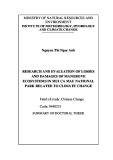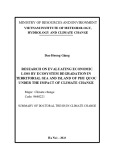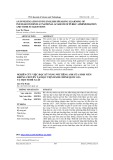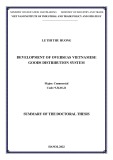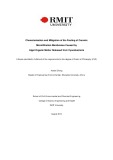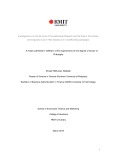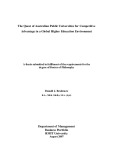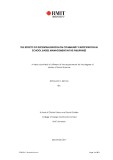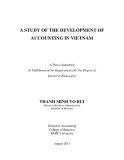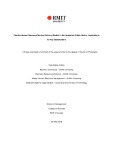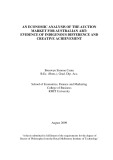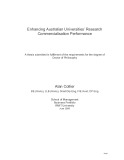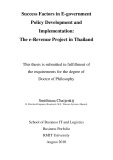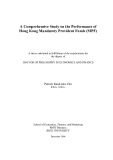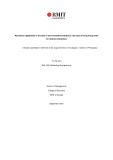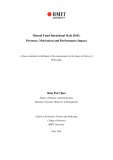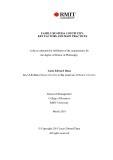MINISTRY OF HOME AFFAIRS
MINISTRY OF EDUCATION AND
TRAINING
ACADEMY OF PUBLIC ADMINISTRATION
DINH LAM TAN
THE ASSESSMENT OF SOCIO- ECONOMIC DEVELOPMENT PLAN IN VIETNAM
Major: Public Administration
Code: 62 34 82 01
SUMMARY OF DOCTORAL THESIS ON PUBLIC ADMINISTRATION
HANOI-2015
This work is completed at: Academy of Public Administration
Supervisions: Assoc. Prof. Dr.Pham KienCuong
Dr. Nguyen Van Trung
Opponent 1: …………………………………………………
……………………………………………………..
Opponent 2:…………………………………………………..
…………………………………………………...
Opponent 3:…………………………………………………..
…………………………………………………...
The thesis will be defended at the witness of the Thesis Evaluation
Council at the Academy level.
Location: Room of defending
the doctoral
thesis–Meeting
room…Building…..
Academy of Public Administration No.: 77 –Nguyen Chi Thanh Street–Dong
Da District - Hanoi.
Time: at…..hour…..date…..month…..2014
It’s possible to search about the Thesis at the National Library of
Vietnamor the library of the Academy of Public Administration.
INTRODUCTION 1. Reasons for the topics selection:
Nowadays, in most countries, planning is considered a key management tool in the public policies implementation process to promote the sustainable development and management of the development achievements. The socio-economic development plan is based on the forecasts of the future context, subjective assumptions and the will of the plan makers. However, in fact, the plans are usually deployed with the conditions that are not absolutely same as the forecasts and assumptions done at first. Therefore, when the plan is implemented, it’s necessary to conduct the assessment to ensure that the plan will be operated and adjusted towards the objectives in the best way.
Today, the planning mechanism has been renovated from the concentrated plan with the objects targets into the orientation plan. However, the focus of the current evaluation reports is mainly the plan implementation and deployment process. The information provided by these reports have not met the requirements for determining whether the outputs of that policy or plan can bring results and impacts as expected or not due to there is no logic relationship between the output with the results and impacts. In keeping with the plan innovation, it requires to conduct the innovation of the implementation evaluation into the results evaluation.
Formatted: Justified, Indent: First line: 0.2", Space Before: 0 pt, After: 0 pt, Line spacing: Exactly 17 pt, Tab stops: Not at 1.09"
Besides, the voters and delegates of the National Assembly are increasingly concerned to the activities of the Government. As a result, to enhance the democracy and transparency in the plan evaluation is essential. Moreover, the international sponsors and the developed partners increasingly require the transparency and the effectiveness of the projects at higher level funded by them, and the cooperation through the results-based evaluation system.
Formatted: Font: (Default) +Headings, No underline, Font color: Auto, (Asian) Japanese (Japan), (Other) English (United States)
Formatted: Font: (Default) +Headings, No underline, Font color: Auto, (Asian) Japanese (Japan), (Other) English (United States)
Formatted: Font: (Default) +Headings, No underline, Font color: Auto, (Asian) Japanese (Japan), (Other) English (United States)
Formatted: Font: (Default) +Headings, No underline, Font color: Auto, (Asian) Japanese (Japan), (Other) English (United States)
Formatted: Font: (Default) +Headings, Not Italic, No underline, Font color: Auto, (Asian) Japanese (Japan), (Other) English (United States)
Formatted: Font: (Default) +Headings, Not Italic, No underline, Font color: Auto, (Asian) Japanese (Japan), (Other) English (United States)
Consequently, the innovation of the plans assessment methods towards building a system and evaluation method to reflect the results and the expected impacts of the plan implementation through a logical relationship between inputs and outputs with the results and impacts is significant and consistent with the current development stage. Derived from such essential requirements, the author selected the topic “Building the assessment method of the socio-economic development plan in Vietnam today” as his doctoral thesis with the expectation that based on the current state of the evaluation of the implementation plan in our country today along with the theoretical basis and specific experiences to propose the solutions and methods to deploy the implementation so as to gradually complete the renovation to develop an assessment method of the socio-economic development plan implementation in accordance with the new development stage of the country. 2. Researching objectives and obligations of the thesis:
Formatted: Font: (Default) +Headings, No underline, Font color: Auto, (Asian) Japanese (Japan), (Other) English (United States)
The objective of the thesis is to analyze the current status of the assessment of Vietnam on the socio-economic development plan. Then, to propose some proposals to innovate and
complete the soci-economic development plan assessment towards approaching based on the results.
3. Researching objects and scopes of the thesis:
Researching objects and scopes of the thesis include: The assessment at the Central level of Vietnam on the implementation of the socio-economic development plan at the National level.
In addition to the focus on the main researching object: the current status of the evaluation used to evaluate the results of the plan implementation, the thesis also incorporated into the analysis of the limitations of the contents of the socio-economic development plan today (due to those limitations, it’s very difficult to use an assessment system in accordance with the international practices and the assessment results pointed out are incorrect, the use of traditional assessment due to the plan contents are not innovated) to find out the necessary changes in accordance with the application of new assessment method.
4. Reasearching method of the thesis:
Formatted: Justified, Indent: First line: 0.2", Space Before: 0 pt, After: 0 pt, Line spacing: Exactly 17 pt, Tab stops: Not at 0.75"
Formatted: Font: (Default) +Headings, No underline, Font color: Auto, (Asian) Japanese (Japan), Not Expanded by / Condensed by
Formatted: Font: (Default) +Headings, No underline, Font color: Auto, (Asian) Japanese (Japan), Not Expanded by / Condensed by
Formatted: Font: (Default) +Headings, No underline, Font color: Auto, (Asian) Japanese (Japan), Not Expanded by / Condensed by
Formatted: Font: (Default) +Headings, No underline, Font color: Auto, (Asian) Japanese (Japan), (Other) English (United States), Not Expanded by / Condensed by
The researching process is carried out sequentially, according to a strict process from the theoretical and practical study to the analysis and assessment of the current status and on the basis of these findings to point out the recommendations and orientations to innovate the assessment of the socio-economic development plan in the next time hiện nay. The thesis uses a combination of different research methods, particularly: The historical materialism methodology and dialectical materialism methodology; inherited methods; Statistical Analysis Methods; Method of quantitative analysis; Comparative methods. Moreover, the thesis also uses the expert consultation method; uses the products and relevant research results. 5. New findings of the thesis:
Formatted: Justified, Indent: First line: 0.2", Space Before: 0 pt, After: 0 pt, Line spacing: Exactly 17 pt, Tab stops: Not at 0.75"
Formatted: Font: (Default) +Headings, No underline, Font color: Auto, (Asian) Japanese (Japan)
Formatted: Font: (Default) +Headings, No underline, Font color: Auto, (Asian) Japanese (Japan), (Other) English (United States)
Formatted: Font: (Default) +Headings, No underline, Font color: Auto, (Asian) Japanese (Japan)
Formatted: Font: (Default) +Headings, No underline, Font color: Auto, (Asian) Japanese (Japan)
The work focuses on researching the theoretical, legal and practical system to gradually improve the assessment content of the socio-economic development plan of the country. Xây dựng cơ sở khoa học phương pháp đánh giá đối với kế hoạch phát triển kinh tế - xã hội của Việt Nam trong giai đoạn hiện nay. Comprehensively assess the current status of the assessment of the socio-economic development plan of Vietnam in the last period. On that basis, propose the scientific foundation and innovate the assessment of the socio-economic development plan of Vietnam based on the results in accordance with the new development stage.
Formatted: Justified, Indent: First line: 0.2", Space Before: 0 pt, After: 0 pt, Line spacing: Exactly 17 pt, Tab stops: Not at 0.75"
Formatted: Font: (Default) +Headings, No underline, Font color: Auto, (Asian) Japanese (Japan), (Other) English (United States)
The research results of the thesis can be used as the materials for teaching and learning subjects in the field of the State management at economic and State management schools and academies and the references for the policy makers. 6. The theoretical and practical significance of the thesis:
Formatted: Font: (Default) +Headings, No underline, Font color: Auto, (Asian) Japanese (Japan), (Other) English (United States)
This is a significant work in the theoretical basis development on the assessment, research of assessment experiences and the assessment based on the results of the countries to form the assessment methods based on the results of the socio-economic development plan of Vietnam in the next period. The content of recommendations, proposals and suggestions of the study is very actual problems today and necessary for all levels, ministries, department and localities for reference when researching and planning the policies.
7. The structure of the thesis:
Formatted: Font: (Default) +Headings, No underline, Font color: Auto, (Asian) Japanese (Japan), (Other) English (United States)
Formatted: Font: (Default) +Headings, No underline, Font color: Auto, (Asian) Japanese (Japan), (Other) English (United States)
Formatted: Font: (Default) +Headings, No underline, Font color: Auto, (Asian) Japanese (Japan), (Other) English (United States)
In addition to the introduction, conclusion, appendix, references, the thesis includes 3 chapters: Chapter I: Theoretical basis on the assessment of the socio-economic development plan in Vietnam; Chapter II: The current status on the assessment of the socio-economic development plan in Vietnam; Chapter III. The orientations and solutions on the innovation and assessment of the socio-economic development plan in Vietnam trong giai đoạn phát triển hiện nay.
Formatted: Font: (Default) +Headings, No underline, Font color: Auto, (Asian) Japanese (Japan), (Other) English (United States)
INTRODUCTION TO RESEARCH SITUATIONS
Formatted: Font: (Default) +Headings, No underline, Font color: Auto, (Asian) Japanese (Japan), (Other) English (United States)
Formatted: Font: (Default) +Headings, No underline, Font color: Auto, (Asian) Japanese (Japan), (Other) English (United States)
Formatted: Centered, None, Line spacing: Exactly 17 pt, No widow/orphan control, Tab stops: 0.75", Left
Formatted: Font: (Default) +Headings, Bold, No underline, Font color: Auto
Formatted: Font: (Default) +Headings, Bold
Formatted: Font: (Default) +Headings, 11 pt, Bold, No underline, Font color: Auto, English (United States)
1. The analysis and assessment of some thesis related-findings. PHÂN TÍCH, ĐÁNH GIÁ MỘT SỐ CÔNG TRÌNH NGHIÊN CỨU LIÊN QUAN ĐẾN ĐỀ TÀI LUẬN ÁN 1.1. Foreign works, articles and scientific research books In the developed countries, especially, the countries in the Organization for Economic Co- operation and Development (OECD), has over 25 years of experience in the field of the assessment based on the results; while many developing countries, including Vietnam, have already began researching and applying this public administration tool. The developed countries chose different starting points when implementing the socio-economic results assessment system, including the research method and entire government approach or the mixed approach.
Formatted: Font: (Default) +Headings, 11 pt, Bold, No underline, Font color: Auto, English (United States)
Formatted: Font: (Default) +Headings, 11 pt, Bold, No underline, Font color: Auto, English (United States)
Formatted: Font: (Default) +Headings, 11 pt
Some foreign scientific works on the research contents: (1) Linda G.Morra Imas and Ray C.Rist, “The Road to Results: Designing and Conducting Effective Development Evaluations”: this is the basic reference of the thesis; this book provided basic foundations on the assessment, the principles and standards of the development assessment; introduction to the assessment in some developed and developing countries; general approach methods in the assessment, etc; (2) Jody Zall Kusek and Ray C. Rist, “Ten Steps to a Results-based Monitoring and Evaluation System”: This book points out the ten step model towards in designing and building the results-based monitoring and evaluation system. (3) Keith Mackay, “How to build the evaluation system to support the Government in a more effective manner”, the Independent Evaluation Group (IEG) of the World Bank (WB), 2007: Confirm that the evaluation is a very important obligation in the management and it decides the success or failure of the policy planning, budget distribution, management and representation; (4) the Asian Development Bank (ADB), the results management capacity - the guidance on the rapid assessment implementation of the capacity of the developing countries in the results
management: Accordingly, this study proposes 5 issues groups for the implementation relating to: obligations, scopes, objectives and principles for the results management; (5) Handbook on Planning, monitoring and evaluating for developmnet results: The research indicates that to plan, monitor and evaluate the results of a nation, it requires to focus on the priorities and development results of that country; (6) An introduction to Results Management, Principles, Implications, and Applications: the research introduces ina general way on the principles, significance and application results management. Many contents mentioned in the book such as the principles in the results management, results management and assessment tools are helpful references for the thesis.
1.2. Domestic works, articles and scientific research books:
The results-based assessment for the plan is currently a new issue, both in research as well as management of our country; in fact, this is an issue in the process of research and pilot application. Some works of the domestic scientists mention to this content: (1) The current status and innovative solutions in making, monitoring and evaluating the implementation of the socio-economic development plan (Dr. Nguyen Thi Phu Ha); (2) Guidance on the analysis and forecast in making, monitoring and evaluating the local development plan, Ministry of Planning and Investment; (3) Researching and building the analytical framework of the implementation of the socio-economic development strategy (Nguyen Thi Ngoc Van). Some other works: Summary record of the innovative conference on planning and investment; From the cognitive process to the innovative practice of planning and public investment in our country (Dr. Cao Viet Sinh); The renovation of the socio- economic development plan: a necessary and urgent issue in the coming period (Le Viet Thai), etc. 2. INTRODUCTION TO THE CONTENTS FOR FURTHER STUDIES 2.1. The practical necessity for research: Along with the economic innovation of the country, planing has to be renewed step by step that contributes significantly into the success of the country for over the last 25 years. The role of planning in the economy continued to be affirmed by the Party and State. Although there have been some positive changes in the innovation of planning in recent years. However, there have many drawbacks in the plan evaluation. Therefore, the plan innovation and evaluation towards enabling to reflect the results and the expected impacts of the plan implementation through a logical relationship between the input and output indexes with the results and impacts are essential.
2.2. The evaluations through researching some domestic and foreign topics on the plan assessment. Through the research, analysis and assessment of some domestic and foreign works, it indicates that until now, there have been any deep research works on the assessment of the socio-economic development plan at the Doctoral level. The researchers have already proposed, approached and researched on the general theory or partly, issues groups or each
secion, aspect, etc and also implemented in a pilot nature in some localities but not in an integrate manner to research and apply for the entire national economy.
However, the domestic and foreign research works as mentioned above are significant in both theoretical and practical way, suggesting the research directions, and it’s very helpful for the author during the reference and building his own thesis.
CHAPTER I: THE THEORETICAL BASIS ON THE ASSESSMENT OF THE SOCIO- ECONOMIC DEVELOPMENT PLAN IN VIETNAM. 1.1. The socio-economic development plan 1.1.1. Basic definition of the plan Plan is the expression of the objectives, results as well as the methods, solutions for the future activities. In the aspect of the development plan associated with the content of the management process, the plan is under the first and the most important function of the management process.
1.1.2. The socio-economic development plan As an economic management tool of the State according to the objectives, represented by the socio-economic development orientation objectives required to achieve in a certain period of a nation or of a locality and the solutions and policies to gain the objective set out in the most efficient way.
Types and levels of the plan:
The socio-economic development plan (PTKTXH) is divided into 4 levels: National level; Provincial/City level directly under the Central Government; District/Town level; Commune/Ward/Town level.
The socio-economic development plan can be classified according to the time and scope. In terms of the time, the socio-economic development plan includes: (i) The medium-term socio-economic development plan (5 years); (ii) the short-term socio-economic development plan (annually). In terms of the extent, the socio-economic development plan includes: (i) the socio-economic development plan at National level; (ii) the socio-economic development plan of the provinces and cities; (iii) the socio-economic development plan of the departments and aspects.
The role of the plan in the socialist-oriented market economy in Vietnam, can be generalized as follows: (1) The socio-economic development plan is a management tool of the State to orient the development of the economy and society, environmental and administration, security and defense; (2) a tool to regulate the market economy; (3) the basis for forming a legal framework for administration; (4) play a role to adjust and regulate the development among regions and segments of the population and the economic sectors.
1.1.3. Structure of the report on the socio-economic development plan A report on the socio-economic development plan often includes two main parts: the assessment of the implementation of the socio-economic development plan at the previous period and the socio-economic development plan at the planning period. In addition, the reports on the socio-economic development plan attach appendixes, including the appendixes on the plan at the previous period, appendixes on the criteria and orientation of the socio- economic development at the planning period.
1.1.4. Planning process of the socio-economic development plan in Vietnam The planning process of the socio-economic development plan includes basic steps as follows: to build the plan, deploy the plan implementation, monitoring and assess the plan (see Diagram 1.3). Building plan
Monitoring plan
Deploying the plan implementation
Assessing plan
Diagram 1.3. Diagram of the planning process of the socio-economic development plan
Formatted: Font: (Default) +Headings, 11 pt, No underline, Font color: Auto
Formatted: Indent: First line: 0.2", Space Before: 0 pt, After: 0 pt, Line spacing: Exactly 16 pt
Formatted: Font: (Default) +Headings, 11 pt
1.12. TỔNG QUAN VỀ PHƯƠNG PHÁP The assessment of the socio-economic development plan
Formatted: Font: (Default) +Headings, 11 pt, No underline, Font color: Auto
Formatted: Font: (Default) +Headings, 11 pt, English (United States)
Formatted: Font: (Default) +Headings, 11 pt, Not Bold, No underline, Font color: Auto
1.12.1. Introduction to the assessment 1.12.1.1. The definition of the assessment There are a lot of definitions of the assessment. According to Michael Scriven, there are approximately different sixty terms used to indicate the assessment.
Formatted: Font: (Default) +Headings, 11 pt, Not Bold, No underline, Font color: Auto
According to the textbook “Development planning”, the assessment is to determine, reflect the results implemented and to consider their values. Assessment can be implemented by the managers (self-evaluate) or by the relevant person (participate in evaluating) or both of them.
Assessment is a process of summarizing, analyzing in a systematic way a project, program or a plan in the implementation progress or finished, including the assessment from making plan, designing program and project to the implementation process and results.
1.2.1.2. The assessment objectives According to the popular opinion, there are four objectives in the assessment: (1) Compliance with the morality; (2) Management objectives; (3) Decision-making objectives and (4) Education and encouragement objectives.
1.2.1.3. The assessment benefits Assessment helps us answer questions about the intervention activities such as: (1) What impacts does it bring? (2) Is it implemented as the plan? (3) Are there any differences in the intervention deployment in other regions? (4) Who is entitled to from this intervention? 1.2.1.4. The assessment objects
Assessment can consider many development levels (see Table 1.1). Some levels can be listed as follows: project; program; policy; organization; department; topic; national support. 1.2.1.5. The assessment use There can be many assessment objectives and effects (see Box 1.1)
There are many forms to use the assessment as follows: • Serve for making decisions of the resource allocation • Serve for considering the cause of the problem • Determine the arising problems • Support to make decision to select the best solution • Support in reform and innovation • Give the general awareness on the causes of problems and solutions. Box 1.1. The assessment use
Formatted: Font: (Default) +Headings, 11 pt, Not Bold, No underline, Font color: Auto
Formatted: Font: (Default) +Headings, 11 pt, Not Bold, No underline, Font color: Auto
Formatted: Font: (Default) +Headings, 11 pt, Not Bold, No underline, Font color: Auto
Formatted: Font: (Default) +Headings, 11 pt, Not Bold, No underline, Font color: Auto
Formatted: Font: (Default) +Headings, 11 pt, Not Bold, No underline, Font color: Auto
1.2.2. The assessment of the socio-economic development plan In terms of principles, to assess the socio-economic development plan, there are two common forms of assessment: (1) Assessment of the implementation deployment (traditional assessment); (2) Results-based assessment. 1.2.2.1. Assessment of the implementation deployment The assessment of the implementation deployment focuses on the implementation, designed to solve the problem of the compliance – response of the questions: (1) Have implemented it or not?; (2) Have mobilized necessary inputs or not?; (3) Have implemented and completed the activities as agreed or not?; (4) Have provided outputs (goods and services) as regulated or not? 1.2.2.2. Results-based assessment The results-based assessment is designed to answer the questions: (1) How then?; (2) Outputs have been created, and how then?; (3) Activities have been completed, and how then? (4) Outputs of these activities have been calculated, and how then? The results-based assessment provides the feedbacks about the real results and objectives of the Government. 1.2.2.3. Compare between the assessment of the implementation deployment and the results- based assessment • Assessment of the implementation deployment (traditional assessment): focuses on assessing inputs, activities and outputs (it means that the implementation of the project or program). Assessment of the implementation deployment answers the question “Have they implemented that task?”. Basic limitation of the assessment of the implementation deployment is difficult to help the policy makers and the relevant parties recognize how the projects or programs to affect the development process or the material and spiritual life of people. • Results-based assessment combines the traditional approach with the assessment of outputs and impacts or results in general.
Formatted: TIEU DE 3, Level 3, Indent: First line: 0.2", Space Before: 0 pt, After: 0 pt, Line spacing: Exactly 17 pt
Formatted
... [1]
Results-based assessment aims at recovering weak points of the traditional assessment and answering the question that the traditional assessment has not answered, those are: (1)
Formatted
... [2]
Formatted: Centered, Level 1, Space Before: 0 pt, Line spacing: Exactly 17 pt
Formatted: Font: 11 pt
Formatted: None, Space Before: 0 pt, After: 0 pt, Line spacing: Exactly 16 pt, Don't keep with next
Formatted: Font: 11 pt
what are objectives? (2) Have those objective been achieved? (3) how are the achieved results demonstrated? (see Table 1.3) Table 1.3 5: Bảng 1. 22: Compare and assess according to the implementation deployment and results The assessment of results The assessment of implementation deployment
Formatted: Font: 11 pt, No underline, Font color: Auto
- Mainly focus on the input, output objectives without mentioning much to results objectives. - Mainly focus on the objectives and impacts.
Formatted: None, Space Before: 0 pt, After: 0 pt, Line spacing: Exactly 16 pt, Don't keep with next
Formatted
... [4]
Formatted
- The information system is poor without sufficient concern. - The information system is improved.
... [3]
Formatted
... [6]
Formatted: Font: 11 pt, No underline, Font color: Auto
- The assessment responsibility is assigned in the internal department without connecting to the external units.
Formatted: None, Space Before: 0 pt, After: 0 pt, Line spacing: Exactly 16 pt, Don't keep with next
Formatted
... [5]
- People do not know the clear results of the local authority, what they gained and how they affect them. - The assessment responsibility is assigned in a more particular and clear way. - People know the clear results of the local authority, what they gained and how they affect them.
Formatted
... [8]
Formatted: Font: 11 pt, No underline, Font color: Auto
- Lack the transparency. - Increase the transparency.
Formatted: None, Space Before: 0 pt, After: 0 pt, Line spacing: Exactly 16 pt, Don't keep with next
Formatted
- The policy makers cannot monitor the implementation process and impacts of the plan and program
... [7]
Formatted
... [11]
Formatted: Font: 11 pt, No underline, Font color: Auto
- The policy makers can monitor the implementation process and impacts of the plan => Make timely adjustment of programs and policies if necessary Source: Summarized researches of the authors
Formatted
... [9]
Formatted
... [10]
Formatted
... [12]
Formatted
... [13]
Formatted
... [14]
Formatted
... [15]
Formatted
... [19]
1.43. Experience in the plan assessment of some countries and lessons for Vietnam Experiences of some countries in the region (China, Korea, India); some developed economies (U.S, Japan, France); the North European countries and some developing economies (Colombia, Brazil) The experience lessons for Vietnam to get a good assessment system: Firstly, require a strong commitment of the leaders of the Party and State.
Formatted
... [16]
Formatted
... [17]
Secondly, the assessment should be considered when beginning the plan construction.
Formatted
... [18]
Formatted
... [20]
Formatted
... [21]
Thirdly, Require an international assistance in the provision of financial, technical and experts supports for enhancing the capacity in the assessment implementation.
Formatted
... [22]
Formatted
... [23]
Formatted
... [24]
Fourth, the assessment information must be public and used positively, clearly defined the explanation responsibility for unreached targets. At the same time, Require a data audit system to ensure that the data provided is reliable and not distorted.
SUB-CONCLUSION OF CHAPTER I Chapter I showed a general picture of theoretical basis and role of the socio-economic development plan, evaluation on plans which have been being done, some experiences in establishing and evaluating other countries’ plans. By that, it asserted the important role of plan evaluation. No matter any political mechanism is, or any developed or developing country is, it cannot lack of the role of planning and plan evaluation. These are important basis for proposing, or recommending to construction renovation, evaluating socio- economic development plan of our country stated in Chapter III.
II: REALITY OF EVALUATING
SOCIO-ECONOMIC
CHAPTER
DEVELOPMENT PLAN IN VIETNAM
2.1. Current socio-economic development plan and obstacles to applicability of
evaluation system basing on the result
Though there have been a lot of innovation in planning, structure of the economic – social development plan still has many unreasonable content, causing obstacles to evaluation basing on the result. Details as follows:
Formatted: TIEU DE 2, Indent: First line: 0.2", Space Before: 0 pt, After: 0 pt, Line spacing: Exactly 17 pt, Widow/Orphan control
2.1.1. Lack of selective feature In the proposed plan, most content was described in “jackfruit model”, with many general targets, tasks, implementing route and mechanism, performing plan, evaluation criteria or priority criteria to realize these wishes. In the plan of ministries and departments, there were still confusion between target and index, criteria and index and kinds of indexes (input, performance, output, result, impact, etc)
2.1.2. The proposed targets were not specific lacking of cohesion between the
planned target and resources
Formatted: Font: 12 pt, Not Bold, Not Italic, Font color: Text 1
Targets were often wordy, complex, overlapped, unattached to the resources causing
difficulty in evaluation (see box 2.1)
Fifth, require to meet enough resouces to maintain the assessment system.
Formatted: Font: (Default) Times New Roman, 11 pt
Formatted: Caption,(Table Title), Indent: First line: 0.5"
Formatted: Font: (Default) Times New Roman
Formatted: Font: Italic
Formatted: Font: (Default) +Headings, Italic
Target of “Building more district hospital” – this was not good because it didn’t focus on the final result, impact which need to be achieved. It should be better to have a target of “Increase the ratio of sick 2.1.3. System of plan targets has many shortcomings Mostly targets focused on input/performance and output indicators such as: building infrastructure, industrial, agricultural manufacture and etc. and impact indicator as poverty reduce but they were not fixed the output with the results and impact of plan implementation. Evaluating the socio-economic development plan is done via the socio- economic criteria system. This system is divided in 3 groups:
Box 2.2 Example on creating plan target
(1) Criteria showing the governmental commitment; (2) Criteria of plan assignment;
(3) Criteria for plan prediction.
2.2. Reality of administration decentralization of planning system 2.2.1. Current administration decentralization of planning system For classification, the plan system was not organized vertically, but strictly distributed responsibility to all ministries, branches and localities. This helps decentralized units be active in monitoring and evaluating plan performance.
2.2.2. Shortcoming of current administration decentralization of planning system Though the policy of decentralization offered activeness to the juniors, without regulations and good coordination, the picture of national socio-economic development may have inconsistencies. Specially, because of unclear regulations of plan evaluation, supervision and assessment of senior agencies to the juniors was still undisciplined, causing distortion in reports of juniors due to local benefits and achievement disease.
2.3 The actual status of evaluating Socio-economic Development Plan at present
2.3.1 Actual status of evaluation system on the socio-economic Development Plant
currently
At present, there is not any specific system which regulates the work of evaluating
Socio-economic Development Plan. Therefore, the legal situation to form the system and
tool of evaluation is not obvious causing the arbitrariness in evaluating the Socio-economic
Development plan without reflecting the real nature of plan`s content.
In fact, I the 5 year plan 2011-2015, the Government has not issued yet the
framework of monitoring and evaluating plan that applies for the whole nation, the plan is
just applied at some localities; thus, the objectives of building in 2011-2015 plan as well as
evaluation report, evaluation method for plan were basically built in the traditional way.
Therefore, researching to create the evaluation method which bases on the result of
Socio-Economic Development Plan, requisite requirements for implementation are in need
of carrying out scientifically, seriously assisting for the future plans.
2.3.2 The actual status of evaluation report on the current Socio-Economic
Development Plan
Because of using the traditional plan to evaluate plan, the evaluation reports on
Socio-Economic Development Plan in 5 years and in each year were in the old and
traditional way without basing on the actual result.
Therefore, there is not a proper and logical evaluation system which makes the
form of presentation lacking of abundance, attractiveness; it depends much on the
objectiveness of the executive agency and units. On the other hand, there still has the
notion indicating that it is the political report or report to submit the leader, thus it was not
paid attention properly in term of content and appearance
2.3. The actual status of techniques for data collection, information combination in
evaluating Socio-Economic Development Plan by the current tool
Firstly, the technique of data collection is limited
Secondly, the accuracy of information is not high and unifying
Thirdly, information is not sufficient
Fourthly, Information is not updated
Lastly, information is separated 2.3.4 The actual status of qualification staffs in charge of evaluating the Socio-
Economic Development Plan currently
At present the number of staffs implement the work of evaluating plan is slender in
term of quality as well as quantity. Because of the fact that the planning staffs made
familiar with the method of evaluation, implementation without training regularly,
continuously in dimensions of knowledge and skills to analyze, evaluate, it is difficult for
them to evaluate basing on result with quick thinking, and executive skills. Besides, the
lack of synchronism in building the evaluation system which bases on the result and
connects the resources causes the lack of trust to this method by the staffs.
SUB-CONCLUSION FOR CHAPTER 2
During the last time, the work of evaluating on the plan execution (the traditional
assessment) assisted the State in controlling the input activities of plan.
However, renovating the evaluation on Socio-economic Development Plan basing
on result is a necessary trend eligible with requirements of the institutional renovating
process of our State, especially the development orientation is building the mode of
socialist oriented market economy, evaluating the “socialism” value in the Socio-
Economic Development Plan is extremely important.
However, to carry out effectively the evaluation method basing on result in
Vietnam at present, it is necessary to have some perquisite conditions such as: applying the
approaching method from the step of making plan, the determination of leader at all levels,
consolidated information system and reorganizing the machinery in charge of evaluation
eligible with requirements on applying the new evaluation method, improving the
professional qualification and etc. These aspects will be mentioned, analyzed and clarified
in the chapter 3.
Chapter 3: Direction and solution for the evaluation innovation on Socio-Economic
Development Plan in Vietnam
3.1 The idea for renovating the evaluation on Socio-Economic Plan in Vietnam
Firstly, renovating the evaluation must attach with the planning innovation
Secondly, renovating the evaluation must be implemented on the foundation of summing
up systematically the actual situation of evaluation in the last time;
Thirdly, Basing on conditions of facilities, budget source and competence of the available
staffs to step by step renovating the work of plan evaluation effectively.
Fourthly, renovating evaluation which ensures to enhance the evaluating competence of
Government, National Assembly; strengthening the democracy, objectiveness in evaluating
the Socio-Economic Development Plan.
3.2 Recommendation for renovating the evaluation on the Socio-Economic
Development Plan in accordance with the evaluation method which bases on result
3.2.1 Perfecting the structure of Socio-Economic Development Plan
Firstly, the objective of plan must be obvious, concrete, and feasible
Secondly, it is vital to have selection in making plan and linking the plan criteria and
resource for implementation
Thirdly, it is necessary to state the relationship between difficulties and solutions
Fourthly, unifying the terms used in the plan
3.2.2 Renovating the evaluating step of Socio-Economic Development Plan.
Making the evaluation plan must be paid attention at the beginning when the Socio-
Economic Development Plan is built because, it is important to make sure that the
proposed plan and drafting must be eligible with the work of evaluation. The content for
making the evaluation plan includes the following steps:
(1) Considering the conditions to establish the evaluation system basing on the result of
Socio-Economic Development Plan
(2) Selecting the results which are in need of evaluation
(3) Selecting the indicators of operation, output, result and indicator of impact to
measure the result;
(4) Checking quality of indicators: Indicators must meet SMART standard. It means
that the indicator must be simple, measurable, affordable, relevant with objectives
and feasible in time bound.
(5) Defining the current data of the evaluating indicator: when gathering information
on the current data for each indicator, it is necessary to define the data source; data
collection methods; data collection agency; data collection frequency; level of
difficulty and expense for data collection; agency that bears responsibility for
analyzing, reporting and using data.
(See figure 3.1)
(6) Defining criteria of result reflection
Impact
Final
Result
Statistical survey
Output
Report
Indicators
Activities
/input
Intermediate indicators
Figure 3.1 Data source for indicators
Carry out the evaluation basing on result
After the steps of making the evaluation plan, it will form a logical frame to follow the result comprising of the results which are in need of evaluation, indicator for measuring results. (Illustration in the table 3.5)
Table 3.5 Example on frame for evaluating the target of children education
Type
Indicator
Level
Responsib le agency
Frequen cy
Data collection method Survey
Impact Percentage of
Nation
5-10 years
reading and writing ability
Result
Impact research Survey
1 time/2 years
Percentage of children going to school
Nation, provinc e
Output Number of
Annuall y
Nation, Provinc e
schools, textbooks for children
Branch information system (report)
Administra tive Report
Activit ies/inp ut
Nation, Provinc e
Quarterl y, annually
Increasing the criteria to primary education
GSO, Ministry of Education and Training Research Institutes GSO, Ministry of Education and Training Ministry of Education and Training Departme nt of Education and Training Ministry of Finance, Ministry of Education and Training Departme nt of Education and Training
Source: Collection and research of author
3.2.3 Evaluation and report of evaluation result
Evaluation: to create the evaluation information using in the evaluating system which
bases on results, depending on each situation, target of plan, it can be selected in
accordance with the following evaluation modes:
(1) Evaluating the logical chain on performance result
(2) Evaluating before implementation
(3) Evaluating the implementation in line with process
(4) Quick verification or quick report
(5) Researching on the typical situation
(6) Evaluating the impact
(7) Integrated evaluation
Report of evaluation result: the report of evaluation result is an important step to
answer the contents: what reported, when and to whom. Information on the operation
result is withdrawn from to provide the necessary and continuous feedback and
update the execution progress of plan. There are four parts in the report: the written
report, overview evaluation, vocal presentation and visual presentation
3.3 The requisite conditions for renovating the evaluation on Socio-Economic-
Development Plan
Renovating the evaluation on Socio-Economic Development Plan is an indispensable
condition to our Nation at present. However, to build and maintain an evaluation
system which bases on result, it is required to have high determination from the
leaders at all levels as well as time, human resource, and financial ability. Offering
the pathway to implement with feasibility is very important. In the period of 5
coming years, it is vital to pay attention to implement some contents: Starting to
establish the institution on evaluation basing on result, forming the national
evaluation database, improving the evaluation competence and mobilizing the human
resource for evaluation basing on result.
SUB-CONCLUSION TO CHAPTER 3
Studying in Chapter 3 mentioned and analyzed content in term of idea, direction,
solution to renovate; some recommendations are very realistic and specific eligible
with the situation of our state, the requisite conditions for obtaining the scientific
foundation, actual status of ideas, and necessary direction in renovating the
evaluation on socio-economic Development Plan which bases on result. Although, it
is renovated from the traditional evaluation method, the plan- simply ingraining in
the thinking and cognition of the policy makers in our country, it is difficult to turn
into the new thinking and cognition in the direction of evaluation which bases on the
output result of plan, it requires the determination of leaders at all levels in terms of
human resource and mental power. However, in the current context, restructuring the
economy, renovating economic institution to find out the new driving force for the
development of our nation focused on by the Party and State extremely, the work of
researching to renovate the plan evaluation is really meaningful, making contribution
to boost the progress of renovating the economic institution of our nation.
CONCLUSION
Evaluating the Socio-Economic Development Plan is an important content in the
process of establishing, implementing the Socio-Economic Development Plan of
Nation. Evaluating the Socio-Economic Development Plan must be renovated when
planning mechanism was renovated from the centralized planning with the object
target into the oriented planning. Therefore, the evaluation method is forced to
renovate to match with the international practices and conditions for development of
our nation in the direction of establishing one evaluation system with ability to reflect
the proposed result, impact from plan performance via the logical relationship
between the output, input indicators with result and impact
With the initiate target, the thesis achieved some following results:
Firstly, generalizing theory on plan, plan evaluation, clarifying the main factors in the
theoretical basis on evaluating the Socio-Economic Development Plan which bases
on result
Secondly, by analyzing the actual status of evaluation, implementation of Socio-
Economic Development Plan, the thesis mentioned some shortcomings in terms of
content, evaluation method on Socio-Economic Development Plan at present
Thirdly, basing on the foundation of analyzing the actual status and international
experience on evaluation, evaluation basing on result, the thesis recommended some
solutions for renovating, giving the evaluation method on the Socio-Economic
Development Plan and executive steps- in the direction of result foundation, offering
the pathway and conditions which are necessary to apply in Vietnam to fit in the
developing period of our nation.
However, evaluation basing on result is a new issue. To carry out the evaluation
method basing on result effectively, it is vital to have a specific pathway, high
determination of leaders and effort from all levels, branches.
Evaluation basing on the result of Socio-Economic Development Plan carried out
effectively will made contribution to meeting requirements of members of National
Assembly and voters in term of responsibility and transparence raising to activities of
Government, creating the close contact with public and trust to citizens, improving
the democracy in plan evaluation
Via the aforementioned research, the thesis offered a group of solutions to renovate
the evaluation method on Socio-Economic Development Plan national level as well
as branch, local levels.
The researching result of thesis bears the actual value and gives consultancy to the
Government in building step by step the complete system of law document on
evaluating the plan in the coming future
In the framework of time, the scale of research and competence of researcher, the
content of Thesis still has limitation; it cannot cover all issues in renovating the plan
evaluation. The researcher wishes to receiver the comments, evaluation and
contribution for completing thesis in the coming future./.
CATALOGUE OF THE CONTENT OF THESIS RELATED-
Formatted: Centered, Space After: 0 pt, Line spacing: Multiple 1.35 li
PUBLISHED WORKS OF THE AUTHOR
Articles published on the Journal of Sciences:
Formatted: Space After: 0 pt, Line spacing: Multiple 1.35 li
1. Dinh Lam Tan (2008), “Introduction to the new methods on assessing the
implementation of the economic development plan during 5 years of
Vietnam - Supervision and evaluation based on the results”, Journal of
Economics and Forecasting, No. 4/2008, Hanoi.
Formatted: Font: 14 pt
2. Dinh Lam Tan(2011), “Economy and Society of Vietnam in 2011 and some
Formatted: Font: 14 pt
solutions for 2012”, Journal of Economics and Forecasting, No.
4/2011, Hanoi.
3. Dinh Lam Tan(2012), “The innovation requirements in building plans
today”, Journal of Economics and Forecasting, No. 22, 11/2012, Hanoi.
4. Dinh Lam Tan(2012), “Discussion of the new approaches in planning the
socio-economic development in Vietnam”, Journal of Economics and
Forecasting, No. 24, 12/2012, Hanoi.
5. Dinh Lam Tan(2013), “The innovation requirements in building the socio-
economic development plan in our country”, Bulletin of
Administration, 1/2013, Hanoi.
Report at the international scientific conferences:
6. Dinh Lam Tan(2009), “Policies on Economy and Investment in Vietnam”,
Report at the ASEAN-Japanese Conference, dated 21/12/2009, Tokyo,
Japan.
Participate in research and evaluation council of the scientific topics
7. Dinh Lam Tan(2012), “Topics on researching and building the analytical
framework of the implementation of the socio-economic development
strategy”, Opponent 1, The scientific topics at the Ministerial levelled
by Nguyen Thi Ngoc Van, General Statistics Office Of Vietnam,
Hanoi.
8. Dinh Lam Tan(2012), “Assessment of the inflation control policy of the
Formatted: Space After: 0 pt, Line spacing: Multiple 1.35 li
Government in the period of 2008-2011”, Opponent 2, The scientific
topics at the Central levelled byDr. Do Duc Chi, National Center for
Socio - Economic Information and Forecast, Hanoi.
9. Dinh Lam Tan(2012), “Building forecasting model of some quarterly
macroeconomic indexes by the application of the transfer function
model and use of the notice indexes”, Opponent 2, The scientific topics
at the Ministerial levelled byDr. Do Van Thanh, Vice-Director
ofNational Center for Socio - Economic Information and Forecast,
Hanoi.
Smart
4/3/2014 12:33:00 PM
Page 11: [1] Formatted Font: (Default) +Headings, 11 pt, Not Bold, No underline, Font color: Auto
Smart
4/3/2014 12:33:00 PM
Page 11: [1] Formatted Font: (Default) +Headings, 11 pt, Not Bold, No underline, Font color: Auto
Smart
4/3/2014 12:33:00 PM
Page 11: [1] Formatted Font: (Default) +Headings, 11 pt, Not Bold, No underline, Font color: Auto
Smart
4/3/2014 12:33:00 PM
Page 11: [1] Formatted Font: (Default) +Headings, 11 pt, Not Bold, No underline, Font color: Auto
Smart
4/3/2014 12:33:00 PM
Page 11: [1] Formatted Font: (Default) +Headings, 11 pt, Not Bold, No underline, Font color: Auto
Smart
4/3/2014 12:33:00 PM
Page 11: [1] Formatted Font: (Default) +Headings, 11 pt, Not Bold, No underline, Font color: Auto
Smart
4/3/2014 2:45:00 PM
Page 11: [2] Formatted Font: 11 pt, No underline, Font color: Auto
Smart
4/3/2014 2:45:00 PM
Page 11: [2] Formatted Font: 11 pt, No underline, Font color: Auto
Smart
4/3/2014 2:45:00 PM
Page 11: [2] Formatted Font: 11 pt, No underline, Font color: Auto
Smart
4/3/2014 2:45:00 PM
Page 11: [2] Formatted Font: 11 pt, No underline, Font color: Auto
Page 11: [3] Formatted
Smart
4/7/2014 1:41:00 PM
Font: 11 pt, No underline, Font color: Auto
Page 11: [3] Formatted
Smart
4/7/2014 1:41:00 PM
Font: 11 pt, No underline, Font color: Auto
Smart
4/7/2014 1:41:00 PM
Page 11: [4] Formatted Font: 11 pt, No underline, Font color: Auto
Smart
4/7/2014 1:41:00 PM
Page 11: [4] Formatted Font: 11 pt, No underline, Font color: Auto
Smart
4/7/2014 1:41:00 PM
Page 11: [4] Formatted Font: 11 pt, No underline, Font color: Auto
Smart
4/7/2014 1:41:00 PM
Page 11: [5] Formatted Font: 11 pt, No underline, Font color: Auto
Smart
4/7/2014 1:41:00 PM
Page 11: [5] Formatted Font: 11 pt, No underline, Font color: Auto
Smart
4/7/2014 1:41:00 PM
Page 11: [6] Formatted Font: 11 pt, No underline, Font color: Auto
Smart
4/7/2014 1:41:00 PM
Page 11: [6] Formatted Font: 11 pt, No underline, Font color: Auto
Smart
4/7/2014 1:41:00 PM
Page 11: [6] Formatted Font: 11 pt, No underline, Font color: Auto
Smart
4/7/2014 1:41:00 PM
Page 11: [7] Formatted Font: 11 pt, No underline, Font color: Auto
Smart
4/7/2014 1:41:00 PM
Page 11: [7] Formatted Font: 11 pt, No underline, Font color: Auto
Smart
4/7/2014 1:41:00 PM
Page 11: [8] Formatted Font: 11 pt, No underline, Font color: Auto
Smart
4/7/2014 1:41:00 PM
Page 11: [8] Formatted Font: 11 pt, No underline, Font color: Auto
Page 11: [9] Formatted
User
5/10/2014 10:35:00 AM
None, Space Before: 0 pt, After: 0 pt, Line spacing: Exactly 16 pt, Don't keep with next
Page 11: [10] Formatted
Smart
4/7/2014 1:41:00 PM
Font: 11 pt, No underline, Font color: Auto
Smart
4/7/2014 1:41:00 PM
Page 11: [10] Formatted Font: 11 pt, No underline, Font color: Auto
Smart
4/7/2014 1:41:00 PM
Page 11: [11] Formatted Font: 11 pt, No underline, Font color: Auto
Smart
4/7/2014 1:41:00 PM
Page 11: [11] Formatted Font: 11 pt, No underline, Font color: Auto
Smart
4/7/2014 1:41:00 PM
Page 11: [11] Formatted Font: 11 pt, No underline, Font color: Auto
Smart
4/7/2014 1:41:00 PM
Page 11: [12] Formatted Font: 11 pt, No underline, Font color: Auto
User
5/10/2014 10:35:00 AM
Page 11: [13] Formatted None, Space Before: 0 pt, After: 0 pt, Line spacing: Exactly 16 pt, Don't keep with next
Smart
4/7/2014 1:41:00 PM
Page 11: [14] Formatted Font: 11 pt, No underline, Font color: Auto
Smart
4/7/2014 1:41:00 PM
Page 11: [14] Formatted Font: 11 pt, No underline, Font color: Auto
Smart
4/7/2014 1:41:00 PM
Page 11: [15] Formatted Font: 11 pt, No underline, Font color: Auto
Smart
4/7/2014 1:41:00 PM
Page 11: [15] Formatted Font: 11 pt, No underline, Font color: Auto
Smart
4/7/2014 1:41:00 PM
Page 11: [15] Formatted Font: 11 pt, No underline, Font color: Auto
Smart
4/7/2014 1:41:00 PM
Page 11: [16] Formatted Font: 11 pt, No underline, Font color: Auto
Page 11: [17] Formatted
User
5/10/2014 10:35:00 AM
None, Space Before: 0 pt, After: 0 pt, Line spacing: Exactly 16 pt, Don't keep with next
Page 11: [18] Formatted
Smart
4/7/2014 1:41:00 PM
Font: 11 pt, Not Bold, Font color: Auto
Smart
4/7/2014 1:41:00 PM
Page 11: [19] Formatted Font: 11 pt, No underline, Font color: Auto
Smart
4/7/2014 1:41:00 PM
Page 11: [19] Formatted Font: 11 pt, No underline, Font color: Auto
Smart
4/7/2014 1:41:00 PM
Page 11: [19] Formatted Font: 11 pt, No underline, Font color: Auto
User
5/10/2014 10:35:00 AM
Page 11: [20] Formatted Space Before: 0 pt, Line spacing: Exactly 17 pt
Smart
4/3/2014 12:33:00 PM
Page 11: [21] Formatted Font: 11 pt, No underline, Font color: Auto
Smart
4/3/2014 12:33:00 PM
Page 11: [21] Formatted Font: 11 pt, No underline, Font color: Auto
Smart
4/3/2014 12:33:00 PM
Page 11: [22] Formatted Font: (Default) +Headings, 11 pt, No underline, Font color: Auto
User
5/10/2014 10:35:00 AM
Page 11: [23] Formatted Indent: First line: 0.2", Space Before: 0 pt, After: 0 pt, Line spacing: Exactly 17 pt
Smart
4/3/2014 12:33:00 PM
Page 11: [24] Formatted Font: (Default) +Headings, 11 pt, No underline, Font color: Auto



